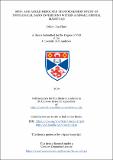Files in this item
Spin- and angle-resolved photoemission study of topological band inversions within a single orbital manifold
Item metadata
| dc.contributor.advisor | King, Phil | |
| dc.contributor.author | Clark, Oliver Jon | |
| dc.coverage.spatial | xviii, 159 p. | en_US |
| dc.date.accessioned | 2019-04-05T08:40:22Z | |
| dc.date.available | 2019-04-05T08:40:22Z | |
| dc.date.issued | 2019-06-24 | |
| dc.identifier.uri | https://hdl.handle.net/10023/17458 | |
| dc.description.abstract | The isolation of graphene in 2004 and the subsequent characterisation of its many remarkable properties marked the start of an intense and ongoing research effort into other systems hosting so-called Dirac cones within their electronic band structures. This thesis focuses on two classes of Dirac materials in particular. Dirac semimetals are essentially three-dimensional analogues of graphene, hosting spin-degenerate Dirac cones within their bulk band structure. Topological insulators are characterised by 'topological surface states' which are spin-polarised, surface-localised Dirac cones, essentially enclosing an otherwise insulating material in a highly conductive outer shell. In both cases, the formation of the Dirac cone requires the crossing of bands within the bulk electronic band structure. In the vast majority of experimental realisations to date, these two bands derive from different atomic and orbital manifolds. Through spin- and angle-resolved photoemission, we establish that Dirac cones arising instead from a single-orbital manifold are both commonplace and advantageous. A mechanism allowing for the simultaneous formation of bulk Dirac cones and topological surface states is introduced, requiring only a discrepancy in bandwidths of a single, crystal field-split orbital manifold along a rotationally-symmetric axis. Unlike in the conventional cases, the Dirac cones populating the resulting 'topological ladders' are not easily destroyed by changes to the relative energetics of orbital manifolds, caused by deformations to a lattice, for example. Instead, lattice deformations can be used to tune the position along the rotationally-symmetric axis where the crossings occur, but the states themselves are extremely robust. Indeed, we demonstrate that topological ladders of a common origin exist in six transition metal dichalcogenide (TMD) compounds, despite their disparate bulk properties and ground states. Moreover, the underlying mechanism driving the formation of topological ladders is expected to be applicable to many other compound classes, suggesting that single-orbital manifold topological phenomena is prevalent in nature. | en_US |
| dc.description.sponsorship | "This work was supported by the EPSRC [Grant No. EP/K503162/1]. " - Acknowledgements | en |
| dc.language.iso | en | en_US |
| dc.publisher | University of St Andrews | |
| dc.relation | Spin- and angle-resolved photoemission study of topological band inversions within a single orbital manifold (Thesis dataset) Clark, O.J., University of St Andrews, DOI: https://doi.org/10.17630/eed8dad8-836b-40e7-8e57-89c8dabed070 | en |
| dc.relation.uri | https://doi.org/10.17630/eed8dad8-836b-40e7-8e57-89c8dabed070 | |
| dc.rights | Attribution-NonCommercial-NoDerivatives 4.0 International | * |
| dc.rights.uri | http://creativecommons.org/licenses/by-nc-nd/4.0/ | * |
| dc.subject | Photoemission | en_US |
| dc.subject | Transition-metal dichalcogenides | en_US |
| dc.subject | Topological insulators | en_US |
| dc.subject | Dirac semimetals | en_US |
| dc.subject.lcc | QC173.458E43C6 | |
| dc.subject.lcsh | Photoemission | en |
| dc.subject.lcsh | Condensed matter | en |
| dc.subject.lcsh | Transition metal compounds | en |
| dc.subject.lcsh | Chalcogenides | en |
| dc.title | Spin- and angle-resolved photoemission study of topological band inversions within a single orbital manifold | en_US |
| dc.type | Thesis | en_US |
| dc.contributor.sponsor | Engineering and Physical Sciences Research Council (EPSRC) | en_US |
| dc.type.qualificationlevel | Doctoral | en_US |
| dc.type.qualificationname | PhD Doctor of Philosophy | en_US |
| dc.publisher.institution | The University of St Andrews | en_US |
| dc.rights.embargoreason | Embargo period has ended, thesis made available in accordance with University regulations. | en |
| dc.identifier.doi | https://doi.org/10.17630/10023-17458 |
The following licence files are associated with this item:
This item appears in the following Collection(s)
Except where otherwise noted within the work, this item's licence for re-use is described as Attribution-NonCommercial-NoDerivatives 4.0 International
Items in the St Andrews Research Repository are protected by copyright, with all rights reserved, unless otherwise indicated.


